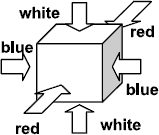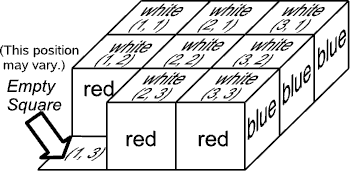POJ-3131-Cubic Eight-Puzzle(双向BFS+哈希)
Description
Let’s play a puzzle using eight cubes placed on a 3 × 3 board leaving one empty square.
Faces of cubes are painted with three colors. As a puzzle step, you can roll one of the cubes to a adjacent empty square. Your goal is to make the specified color pattern visible from above by a number of such steps.
The rules of this puzzle are as follows.
Coloring of Cubes: All the cubes area colored in the same way as shown in Figure 1. The opposite faces have the same color.

Figure 1: Coloring of a cube
Initial Board State: Eight cubes are placed on the 3 × 3 board leaving one empty square. All the cubes have the same orientation as shown in Figure 2. As shown in the figure, squares on the board are given x and y coordinates,
(1, 1), (1, 2), …, and (3, 3). The position of the initially empty square may vary.
Figure 2: Initial board state
Rolling Cubes: At each step, we can choose one of the cubes adjacent to the empty square and roll it into the empty square, leaving the original position empty. Figure 3 shows an example.

Figure 3: Rolling a cube
Goal: The goal of this puzzle is to arrange the cubes so that their top faces form the specified color pattern by a number of cube rolling steps described above.
Your task is to write a program that finds the minimum number of steps required to make the specified color pattern from the given initial state.
Input
The input is a sequence of datasets. The end of the input is indicated by a line containing two zeros separated by a space. The number of datasets is less than 16. Each dataset is formatted as follows.
x y F11 F21 F31 F12 F22 F32 F13 F23 F33
The first line contains two integers x and y separated by a space, indicating the position (x, y) of the initially empty square. The values of x and y are 1, 2, or 3.
The following three lines specify the color pattern to make. Each line contains three characters F1j, F2j, and F3j, separated by a space. Character Fij indicates
the top color of the cube, if any, at the position (i, j) as follows:
B:Blue,
W:White,
R:Red,
E:the square is Empty.
There is exactly one ‘E’ character in each dataset.
Output
For each dataset, output the minimum number of steps to achieve the goal, when the goal can be reached within 30 steps. Otherwise, output “-1” for the dataset.
Sample Input
1 2
W W W
E W W
W W W
2 1
R B W
R W W
E W W
3 3
W B W
B R E
R B R
3 3
B W R
B W R
B E R
2 1
B B B
B R B
B R E
1 1
R R R
W W W
R R E
2 1
R R R
B W B
R R E
3 2
R R R
W E W
R R R
0 0
Sample Output
0
3
13
23
29
30
-1
-1
Source
思路:数据太大,先抽象出状态,再哈希一下,然后就是双向BFS。
#include <stdio.h>
#include <string.h>
#include <stack>
using namespace std;
#define INF 99999999
struct{
int step,state;
}t,que1[1000000],que2[1000000];
stack<int>stk;
bool vis1[5000007],vis2[5000007];
int top1,top2,bottom1,bottom2,mp[9],nxt[2][7]={{0,4,6,5,1,3,2},{0,5,3,2,6,1,4}},head[5000007],next[5000007],val[5000007],total;
int hashval(int x)
{
int t,i;
t=x%5000007;
for(i=head[t];i!=-1;i=next[i])
{
if(val[i]==x) return i;
}
val[total]=x;
next[total]=head[t];
head[t]=total;
total++;
return total-1;
}
void pushtarget(int cnt,int state)
{
if(cnt==-1)
{
vis2[hashval(state)]=1;
que2[bottom2].step=0;
que2[bottom2].state=state;
bottom2++;
return;
}
if(mp[cnt]%2)
{
pushtarget(cnt-1,state*7+mp[cnt]);
pushtarget(cnt-1,state*7+mp[cnt]+1);
}
else pushtarget(cnt-1,state*7);
}
int getstate()
{
int temp=0;
for(int i=8;i>=0;i--)
{
temp=temp*7+mp[i];
}
return temp;
}
void spread(int x)
{
int i=0,temp,cnt,old;
while(i<9)
{
if(x%7==0) cnt=i;
mp[i++]=x%7;
x/=7;
}
cnt+=1;
if(cnt>=0 && cnt<9 && cnt%3>0)
{
old=mp[cnt];
mp[cnt-1]=nxt[0][mp[cnt]];
mp[cnt]=0;
stk.push(getstate());
mp[cnt]=old;
mp[cnt-1]=0;
}
cnt-=1;
cnt-=1;
if(cnt>=0 && cnt<9 && cnt%3<2)
{
old=mp[cnt];
mp[cnt+1]=nxt[0][mp[cnt]];
mp[cnt]=0;
stk.push(getstate());
mp[cnt]=old;
mp[cnt+1]=0;
}
cnt+=1;
cnt-=3;
if(cnt>=0 && cnt<9)
{
old=mp[cnt];
mp[cnt+3]=nxt[1][mp[cnt]];
mp[cnt]=0;
stk.push(getstate());
mp[cnt]=old;
mp[cnt+3]=0;
}
cnt+=3;
cnt+=3;
if(cnt>=0 && cnt<9)
{
old=mp[cnt];
mp[cnt-3]=nxt[1][mp[cnt]];
mp[cnt]=0;
stk.push(getstate());
mp[cnt]=old;
mp[cnt-3]=0;
}
cnt-=3;
}
int bfs()
{
int step1=0,step2=0,ans=INF,temp;
for(step1=0;step1<=20;step1++)
{
while(top1<bottom1 && que1[top1].step==step1)
{
spread(que1[top1].state);
while(!stk.empty())
{
temp=stk.top();
stk.pop();
if(vis2[hashval(temp)])
{
return step1+step2+1;
}
if(!vis1[hashval(temp)])
{
vis1[hashval(temp)]=1;
que1[bottom1].state=temp;
que1[bottom1].step=que1[top1].step+1;
bottom1++;
}
}
top1++;
}
while(top2<bottom2 && que2[top2].step==step2 && step2<9)
{
spread(que2[top2].state);
while(!stk.empty())
{
temp=stk.top();
stk.pop();
if(vis1[hashval(temp)]) return step1+step2+2;
if(!vis2[hashval(temp)])
{
vis2[hashval(temp)]=1;
que2[bottom2].state=temp;
que2[bottom2].step=step2+1;
bottom2++;
}
}
top2++;
}
if(step2<9) step2++;
}
return -1;
}
int main()
{
int x,y,i,j,temp;
char ctemp;
while(~scanf("%d%d",&y,&x) && x)
{
x--;
y--;
top1=top2=bottom1=bottom2=0;
memset(vis1,0,sizeof vis1);
memset(vis2,0,sizeof vis2);
memset(head,-1,sizeof head);
total=0;
while(!stk.empty()) stk.pop();
for(i=0;i<9;i++)
{
ctemp=getchar();
if(ctemp=='\n' || ctemp==' ')
{
i--;
continue;
}
if(ctemp=='W')mp[i]=1;
else if(ctemp=='B') mp[i]=3;
else if(ctemp=='R') mp[i]=5;
else if(ctemp=='E') mp[i]=0;
}
pushtarget(8,0);
temp=0;
for(i=8;i>=0;i--)
{
if(i!=x*3+y) temp=temp*7+1;
else temp*=7;
}
if(vis2[hashval(temp)])
{
printf("0\n");
continue;
}
vis1[hashval(temp)]=1;
que1[bottom1].step=0;
que1[bottom1].state=temp;
bottom1++;
printf("%d\n",bfs());
}
}POJ-3131-Cubic Eight-Puzzle(双向BFS+哈希)的更多相关文章
- UVA-1604 Cubic Eight-Puzzle (双向BFS+状态压缩+限制搜索层数)
题目大意:立体的八数码问题,一次操作是滚动一次方块,问从初始状态到目标状态的最少滚动次数. 题目分析:这道题已知初始状态和目标状态,且又状态数目庞大,适宜用双向BFS.每个小方块有6种状态,整个大方格 ...
- poj 3131 Cubic Eight-Puzzle 双向广搜 Hash判重
挺不错的题目,很锻炼代码能力和调试能力~ 题意:初始格子状态固定,给你移动后格子的状态,问最少需要多少步能到达,如果步数大于30,输出-1. 由于单向搜索状态太多,搜到二十几就会爆了,所以应该想到双向 ...
- POJ 1915 经典马步 双向bfs
拿这个经典题目开刀...........可是双向时间优势在这题上的效果不太明显 #include <iostream> #include <algorithm> #includ ...
- Eight (HDU - 1043|POJ - 1077)(A* | 双向bfs+康拓展开)
The 15-puzzle has been around for over 100 years; even if you don't know it by that name, you've see ...
- POJ 3170 Knights of Ni (暴力,双向BFS)
题意:一个人要从2先走到4再走到3,计算最少路径. 析:其实这个题很水的,就是要注意,在没有到4之前是不能经过3的,一点要注意.其他的就比较简单了,就是一个双向BFS,先从2搜到4,再从3到搜到4, ...
- POJ 3126 Prime Path 解题报告(BFS & 双向BFS)
题目大意:给定一个4位素数,一个目标4位素数.每次变换一位,保证变换后依然是素数,求变换到目标素数的最小步数. 解题报告:直接用最短路. 枚举1000-10000所有素数,如果素数A交换一位可以得到素 ...
- POJ 1915-Knight Moves (单向BFS && 双向BFS 比)
主题链接:Knight Moves 题意:8个方向的 马跳式走法 ,已知起点 和终点,求最短路 研究了一下双向BFS,不是非常难,和普通的BFS一样.双向BFS只是是从 起点和终点同一时候開始搜索,可 ...
- [poj] 2549 Sumsets || 双向bfs
原题 在集合里找到a+b+c=d的最大的d. 显然枚举a,b,c不行,所以将式子移项为a+b=d-c,然后双向bfs,meet int the middle. #include<cstdio&g ...
- POJ——3126Prime Path(双向BFS+素数筛打表)
Prime Path Time Limit: 1000MS Memory Limit: 65536K Total Submissions: 16272 Accepted: 9195 Descr ...
随机推荐
- Python之并行
http://www.open-open.com/news/view/1c0179b/
- Application应用程序级变量
对于每一个网站访问用户都要访问的变量,应该将它设为________变量.(选择1项) A. Session B. Reques C. Response D. Application 解答:D
- 哪一个不是EL定义的隐式对象?(选择1项)
哪一个不是EL定义的隐式对象?(选择1项) A cookie B.pageContext C.attributes D initParam 解答:C 1)pageContext:JSP 页的上下文.它 ...
- Unity获取文件夹下指定类型的文件数量
有个文件夹里面有很多的图片,都是.png格式的,要是一个一个的拖到脚本上觉得很麻烦,就写了一个遍历添加的cars,变量是List<Sprite> 代码如下: using UnityEngi ...
- 【BZOJ】1057: [ZJOI2007]棋盘制作(单调栈)
http://www.lydsy.com/JudgeOnline/problem.php?id=1057 同某一题差不多?记不清是哪题了.. 就是每一行进行单调栈维护递增的高度,在进栈和出栈维护一下长 ...
- mysql插入多行数据
表结构如图:
- hdu 1426:Sudoku Killer(DFS深搜,进阶题目,求数独的解)
Sudoku Killer Time Limit: 2000/1000 MS (Java/Others) Memory Limit: 65536/32768 K (Java/Others)Tot ...
- 有用的Python代码片段
我列出的这些有用的Python代码片段,为我节省了大量的时间,并且我希望他们也能为你节省一些时间.大多数的这些片段出自寻找解决方案,查找博客和StackOverflow解决类似问题的答案.下面所有的代 ...
- (转)python中的参数:*args和**kwargs
def foo(*args, **kwargs):print 'args = ', argsprint 'kwargs = ', kwargsprint '---------------------- ...
- ios开发之--使用AFNetWorking 3.1.0 ,简单的请求封装类
从苹果系统自带的请求类,到ASIHttpRequest第三方请求类,再到AFNetWorking第三方请求类,目前只要牵扯到数据请求,基本上都是用AFN,所以,这里纯粹是记录下: hRequestTo ...
